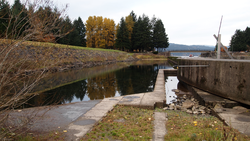Cascades Locks and Canal
|
Cascade Locks Marine Park
|
|

Remnants of the locks as of 2011
|
|
| Location | On the Columbia River, Cascade Locks, Oregon |
|---|---|
| Area | 64.5 acres (26.1 ha) |
| Built | 1896 |
| NRHP reference # | 74001686 |
| Added to NRHP | May 15, 1974 |
The Cascade Locks and Canal was a navigation project on the Columbia River between the U.S. states of Oregon and Washington, completed in 1896. It allowed the steamboats of the Columbia River to bypass the Cascades Rapids, and thereby opened a passage from the lower parts of the river as far as The Dalles. The locks were submerged and rendered obsolete in 1938, when the Bonneville Dam was constructed, along with a new set of locks, a short ways downstream.
As rail competition grew, and forced steamboats off their old routes, shippers and steamboat lines began agitating Congress to allocate funds for improvements to the river, in the form of canals and locks, that would restore their competitive position relative to the railroads. The two main improvements sought on the Columbia were the Cascade Locks and, about twenty years later, the Celilo Canal and Locks.
Studies for a canal at the Cascades had begun in 1875, but interest tapered off when Oregon Railroad and Navigation Company (O.R.& N.) finished the railroad to The Dalles and took its boats off the middle river. Anti-monopoly shippers eventually got Congress to allocate funds in 1893 to begin the canal and locks at the Cascades, which were completed in November 1896. The locks had a lift chamber carved in solid rock 460 feet (140 m) long, and 90' wide, with 8 feet (2.4 m) of draft, deep enough for any vessel then on the river, and large enough to accommodate several at once. The locks could raise a vessel 14' at high water and 24' at low water.
The lock gates were 56 feet (17 m) wide and 90 feet (27 m) high. The locks were carefully designed to address the great variation in the height of the river, the difference between high and low water being 55 feet (17 m). This condition made it necessary to build a series of three sets of gates, increasing in height from the lower entrance to the huge upper guard gate, only two sets being used at one time. When the river was low, the upper guard gates remained open continually and the lower sets were operated. When the water rose enough to drown the lower gates, they were swung open and the lifting work was done by the others. The upper approach was formed by masonry wall extending from the guard gate in a long sweep of 1,200 feet (370 m), and the bank behind was armored against floods with riprapped stone.
...
Wikipedia


